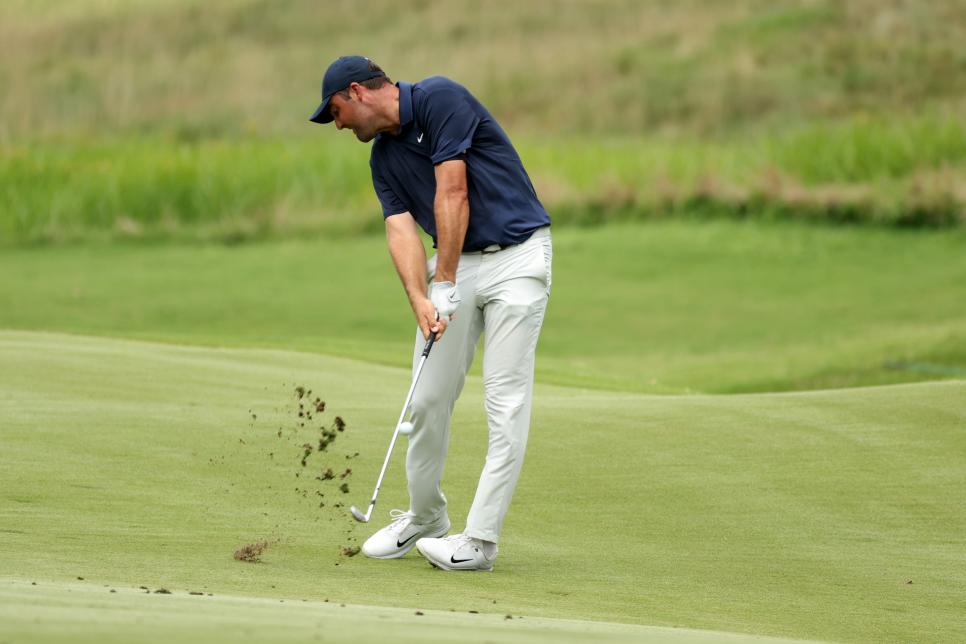[PHOTO: Gregory Shamus]
Wait, that doesn’t sound right. Even if you’re a casual golf fan, you’re probably aware of Scottie Scheffler’s struggles on the greens this year and wondering if we have a typo in the headline. During a season in which he leads the PGA Tour in numerous ball-striking categories, the world No.1 has been dreadful with the putter, ranking outside the top 145 in strokes gained/putting.
With two wins and 13 top 5s(!!), Scheffler has had a fantastic season, but it’s hard not to consider how historic his season would have been with just average putting stats. But even with Scheffler’s troubles on the greens (he ranks outside the top 150 in numerous other putting categories), there is one statistic he leads: approach putt performance.
Normally a helpful stat to judge distance control on the greens, approach putt performance measures how close a player leaves his first putt from the hole on average. This season, no one is better than Scheffler and Ryan Armour, who both average 1 foot, 11 inches for their second putts. As you’d imagine, there is correlation between leaving your first putt close to the hole and avoiding three-putts. It’s little surprise then, that Scheffler is ranked 11th in three-putt avoidance.
The tour’s best short-range putter has some good advice for the rest of us
How can Scheffler have some of the best speed control on tour and be avoiding three-putts but still be near the bottom in numerous major putting categories? What this disparity does and doesn’t reveal is insight for all of us into how we should examine our own games.
What it does reveal
Scheffler leading the tour in approach putt performance says more about his excellent ball-striking than his touch on the greens. This statistic, like many others, cannot be viewed in a vacuum. Scheffler leaves his first putts closer to the hole than any player, but of course not everyone is hitting their first putts from the same distance from the hole.
In addition to leading in strokes gained/approach and greens in regulation, Scheffler is among the best on tour in proximity to the hole. From the fairway, he ranks a solid 21st in proximity, and from the rough he is 13th on tour. Within 30 yards of the green, only three players average closer to the hole. Taken together, Scheffler is hitting his first putts from significantly closer to the hole than most players.

What it doesn’t reveal
Unfortunately for Scheffler, his high ranks in approach putt performance and three-putt avoidance don’t say much about his overall putting. His make percentages from 20-25 feet (150th), 10-15 feet (166th), and 4-8 feet (169th) are near the bottom of the tour. Yes, he is leaving his second putts close to the hole, but 1) he is hitting his first putts from closer on average, and 2) he is holing far fewer short and mid-range putts than most players.
The takeaway
The takeaway for the rest of our games is to be careful in placing too much emphasis on certain stats without thinking about what other factors could be influencing the numbers. A couple good examples are total putts per round and scrambling percentage. As much as it may seem diligent to track these stats at the bottom of your scorecard, they reveal very little on their own.

Let’s say two players have 30 putts in a round – a seemingly decent number. Suppose one player struck it very well and hit 16 of 18 greens, leaving an average first putt of 35 feet. The other player hit just four greens, but on the 14 times they were chipping from around the green, they left themselves with an average putt of 15 feet. Both players had 30 putts, but the player who hit 16 greens had a much better putting day considering their proximity was much farther. If you’re going to track your total putts per round, be sure to consider your greens in regulation and how close you were putting from.
There’s a similar idea with measuring how many times you get up-and-down in a round. A high scrambling percentage on a given day suggests you were chipping and putting well. But which one was it? Sure, you could have done both well, but if you were chipping it to three feet all day, that says far less about your putting than it does your touch around the greens. Or maybe you were knocking in 20-foot par-savers all day. You were getting up-and-down, but you weren’t necessarily chipping well.
Remember, many statistics cannot be viewed in a vacuum. Tracking them is key to understanding your game so you know where you need to improve, but be sure to consider what other factors could be affecting a given stat.



